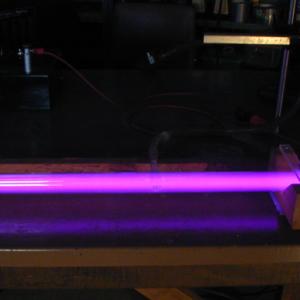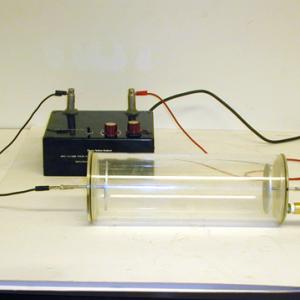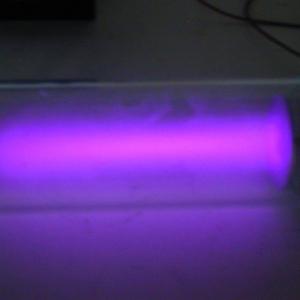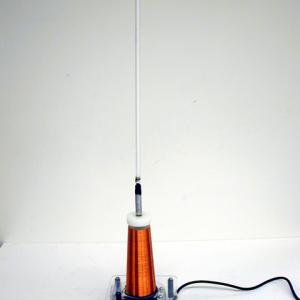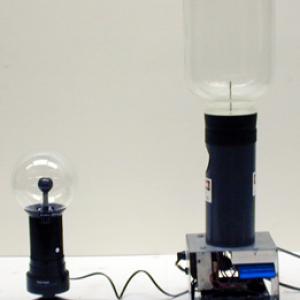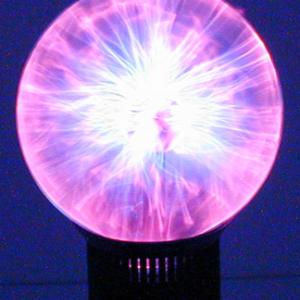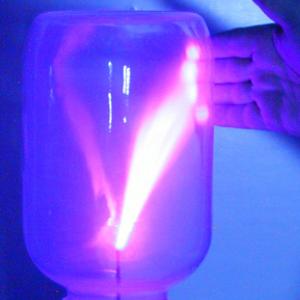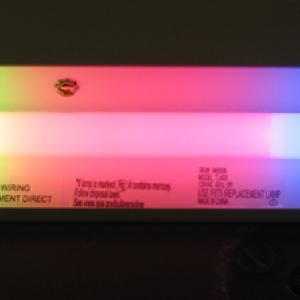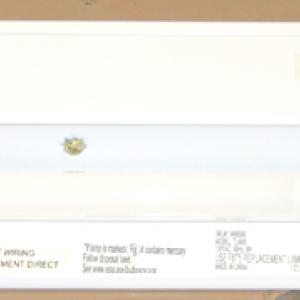College of Liberal Arts & Sciences
7B35.75 - Plasma Tube
Connect the electrodes on the plasma tube to the induction coil. Also, attach the vacuum pump to the plasma tube. Turn on the induction coil and set at about 1/3 power. As you then pump down on the tube you will probably see an electron beam before the whole tube is filled with glowing plasma. This is particularly striking when using the Plexiglas plasma tube.
The Plexiglas tube also has some extra accessories for doing electron beam and magnet demonstrations.
NOTE: Always unscrew the end caps after use so that there is no pressure on the O-rings for extended periods of time. Otherwise the end caps may lock onto the tube and possible breakage could result from any attempts to remove them.
Attach the special plasma tube to the top of the small Tesla coil. As this tube is extremely long and thin, great care should be taken to guard against breakage. Adjust the output power of the coil to give the best glow of the plasma tube.
Plasma effects may also be explored by bringing your hand near a commercial plasma tube.
The luminescent properties of the phosphor coatings on fluorescent tubes may be explored using the bulb that has 1/2 or its length coated and 1/2 or its length uncoated.
- James Lincoln, "Plasma Globe Revisited", TPT, Vol. 56, #1, Jan. 2018, p. 62.
- Nicholas R. Guilbert, "Shedding Some Light on Fluorescent Bulbs", TPT, Vol. 34, #1, Jan. 1996, p. 20.
- Herbert h. Gottslieb, "Apparatus - Extinguishing a Fluorescent Lamp in a Magnetic Field", TPT, Vol. 35, #2, Feb. 1967, p. 86.
- Amy Ffield and Richard Wolfson, "Microwave Measurements of a Fluorescent Lamp Plasma", AJP, Vol. 55, #7, July 1987, p. 637.
- W. F. DiVergilio, P. M. Kam, D. S. Pappas, K. R. MacKenzie, "A Large, Quiescent Plasma Device", AJP, Vol. 42, #2, Feb. 1974, p. 169.
- D. L. Landt, C.M. Burde, H. C. S. Hsuan, K. E. Lonngren", "An Experimental Simulation of Waves in Plasmas", AJP, Vol. 40, #10, Oct. 1972, p. 1493.
- Arnaud Beck, Nicole Meyer-Vernet, "The Trajectory of an Electron in a Plasma", AJP, Vol. 76, #10, Oct. 2008, p. 934.
- Back Scatter, "Grape Balls of Fire!", Physics Today, Vol. 70, #10, Oct. 2017, p. 96.
- Johanna L. Miller, "Powerful Lasers Mimic Intergalactic Plasmas in the Lab", Physics Today, Vol. 68, # 9, Sep. 2015, p. 16.
- Johanna Miller, "Plasma Wakefield Acceleration Shows Promise", Physics Today, Vol. 68, # 1, Jan. 2015, p. 11.
- Donald B. Batchelor, "Integrated Simulation of Fusion Plasmas", Physics Today, Vol. 58, # 2, Feb. 2005, p. 35.
- Julien Clinton Sprott, "4.8, Gas Discharge Tube", Physics Demonstrations, p. 200.
- Jearl Walker, "6.125, Colors in Fluorescent Light", The Flying Circus of Physics, p. 294.
Disclaimer: These demonstrations are provided only for illustrative use by persons affiliated with The University of Iowa and only under the direction of a trained instructor or physicist. The University of Iowa is not responsible for demonstrations performed by those using their own equipment or who choose to use this reference material for their own purpose. The demonstrations included here are within the public domain and can be found in materials contained in libraries, bookstores, and through electronic sources. Performing all or any portion of any of these demonstrations, with or without revisions not depicted here entails inherent risks. These risks include, without limitation, bodily injury (and possibly death), including risks to health that may be temporary or permanent and that may exacerbate a pre-existing medical condition; and property loss or damage. Anyone performing any part of these demonstrations, even with revisions, knowingly and voluntarily assumes all risks associated with them.

